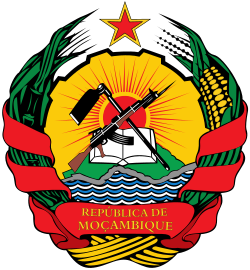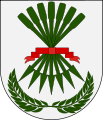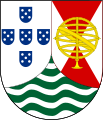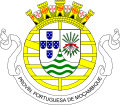
The national flag of Angola came into use when Angola gained independence on November 11, 1975. It is split horizontally into an upper red half and a lower black half with an emblem resting at the center. It features a yellow half gear wheel crossed by a machete and crowned with a star.

The national emblem of Cape Verde contains a circle within which is written the name of the nation in Portuguese. Within the circle are a torch and triangle, symbols of freedom and national unity. At the top of the shield is a plumbob, a symbol of righteousness; three chain links are at the bottom. This emblem replaces the earlier variant with the seashell that had been in use since independence. The current emblem was adopted in 1999.

The Emblem of Guinea-Bissau was adopted shortly after independence from Portugal in 1973.

The national emblem of Angola reflects the recent past of the nation. It includes Marxist imagery found on the device, expanded from what is found on the national flag.

The coat of arms of Brazil was created on 19 November 1889, four days after Brazil became a republic. It consists of the central emblem surrounded by coffee and tobacco branches, which were important crops in Brazil at that time. In the round shield in the center, the Southern Cross can be seen. The ring of 27 stars around it represents Brazil's 26 states and the Federal District.

The national flag of Mozambique is a horizontal tricolour of green, black, and gold with white fimbriations and a red isosceles triangle at the hoist. The triangle is charged with a five-pointed gold star in its center, above which there is a bayonet-equipped AK-47 crossed by a hoe, superimposed on an open book. The current design, adopted on 1 May 1983, is a modified version of the first flag of FRELIMO, which has governed the country since its independence from Portugal on 25 June 1975. Since the democratisation of Mozambique in 1990, there have been calls to change the flag, particularly to remove the AK-47.

A red star, five-pointed and filled, is a symbol that has often historically been associated with communist ideology, particularly in combination with the hammer and sickle, but is also used as a purely socialist symbol in the 21st century. It has been widely used in flags, state emblems, monuments, ornaments, and logos.

The coat of arms of Zimbabwe was adopted on 21 September 1981, one year and five months after the national flag was adopted. Previously the coat of arms of Zimbabwe was identical to the former coat of arms of Rhodesia.

The great seal of the state of Delaware was first adopted on January 17, 1777, with the current version being adopted April 29, 2004. It contains the state coat of arms surrounded by an inscription.

The State Emblem of Uzbekistan was formally adopted on 2 July 1992 by the Government of Uzbekistan. It bears many similarities to the emblem of the former Uzbek Soviet Socialist Republic, which the Republic of Uzbekistan succeeded. Like many other post-Soviet republics whose symbols do not predate the October Revolution, the current emblem retains some components of the Soviet one. Prior to 1992, Uzbekistan had an emblem similar to all other Soviet Republics, with standard communist emblems and insignia.
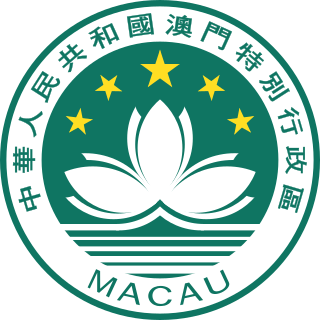
The Regional Emblem of the Macao Special Administrative Region of the People's Republic of China came into use on 20 December 1999, when the sovereignty of Macau was handed over from the Portuguese Republic to the People's Republic of China. The emblem is now referred to officially as the "Regional Emblem" (區徽).

The national emblem of East Timor is one of the national symbols of East Timor.
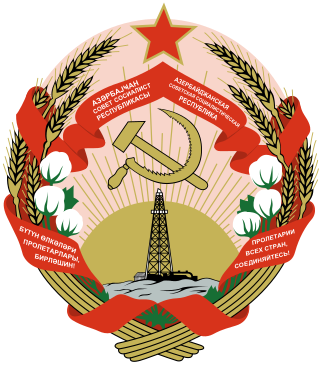
The emblem of the Azerbaijan Soviet Socialist Republic was adopted in 1937 by the government of the Azerbaijan Soviet Socialist Republic. The style is based on the emblem of the Soviet Union.

The State Emblem of the Tajik Soviet Socialist Republic was adopted on 1 March 1937 by the government of the Tajik Soviet Socialist Republic. The emblem is based on the State Emblem of the Soviet Union. It shows symbols of agriculture. The red star is prominently featured with a small hammer and sickle within it. The rising sun stands for the future of the Tajik nation, and the star as well as the hammer and sickle for the victory of communism and the "world-wide socialist community of states". The emblem was replaced with the new emblem in 1992, which uses a similar design to the Soviet one. It was, however, was replacing the red banner with the current national flag, the big red star was replaced by the mountains, represents Pamir, the Samanid dynasty crown, and added the Quran book at below. It represents Islam as the official religion.

The Emblem of the Uzbek Soviet Socialist Republic was adopted on 14 February 1937 by the government of the Uzbek Soviet Socialist Republic. The emblem is based on the emblem of the Soviet Union. It shows symbols of agriculture and heavy industry (hammer). The rising sun over a map of the Soviet Central Asia symbolizes the future of this region, while the five pointed red star stands for the "socialist revolution on all five continents".

Socialist-style emblems usually follow a unique style consisting of communist symbolism. Although commonly referred to as coats of arms, most are not actually traditional heraldic achievements. Many communist governments purposely diverged from heraldic tradition in order to distance themselves from the monarchies that they usually replaced, with coats of arms being seen as symbols of the monarchs.

The People's Republic of Mozambique was a socialist state that existed in present-day Mozambique from 1975 to 1990. It was established when the country gained independence from Portugal in June 1975 and the Mozambican Liberation Front ("FRELIMO") established a one-party socialist state led by Samora Machel. The state enjoyed close political and military ties with the Soviet Union, which was one of the first nations to provide diplomatic recognition and financial support to the fledgling FRELIMO government. For the duration of its history, the People's Republic of Mozambique remained heavily dependent on Soviet aid, both in financial terms as well as with regards to food security, fuel, and other vital economic necessities. From 1977 to 1992, the country was devastated by a deadly civil war which pitted the armed forces against the anti-communist Mozambique National Resistance (RENAMO) insurgency, backed by neighbouring Rhodesia and South Africa.

The coats of arms of the Portuguese Empire's colonies were all of a uniform style following 1935. Two of them had, however, been using provisional coats of arms of the same style shortly prior to this.

The symbols of Portugal are official and unofficial flags, icons or cultural expressions that are emblematic, representative or otherwise characteristic of Portugal and of its culture.
Communist symbolism represents a variety of themes, including revolution, the proletariat, the peasantry, agriculture, or international solidarity. The red flag, the hammer and sickle and the red star or variations thereof are some of the symbols adopted by communist movements, governments, and parties worldwide.
Article 194 The emblem of the Republic of Mozambique shall contain as its central elements a book, a gun and a hoe, superimposed on a map of Mozambique, representing, respectively, education, defense and vigilance, and the peasantry and agricultural production. Below the map the ocean shall be represented. In the center shall be the rising sun, symbol of the building of a new life. Enclosing all this shall be a toothed wheel, symbolizing labor and industry. Surrounding the toothed wheel there shall be, to the right and left respectively, an ear of maize and a piece of sugar cane, symbolizing agricultural wealth. At the bottom there shall be a red strip with the inscription "Republic of Mozambique."
